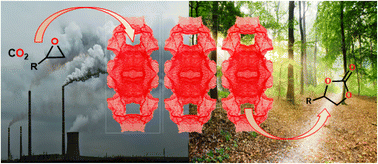An amine decorated MOF for direct capture of CO2 from ambient air†
Abstract
A Zn(II)-based metal–organic framework (MOF) was synthesized by the self-assembly of the dicarboxylate ligand terephthalic acid (TPA), 2-aminoterephthalic acid (NH2-TPA) and N-donor auxiliary ligand 1,4-bis(4-pyridinylmethyl)piperazine (bpmp) using Zn(NO3)2·6H2O under hydrothermal conditions. {[Zn(TPA)0.5(NH2TPA)0.5(bpmp)]·DMF·7H2O}n (framework 1) has an sra topology with a BET surface area of 756 m2 g−1. The microporous nature of the framework is apparent from the significant CO2 adsorption capacities observed at various temperatures: 57 cc g−1 at 283 K, 46 cc g−1 at 293 K, 37 cc g−1 at 303 K, and 30 cc g−1 at 313 K. The considerable CO2 adsorption may be caused by the existence of free carboxylate and amine substituents that interact with the gas molecules and micropores. At room temperature, the activated MOF readily converts CO2 into cyclic carbonates when a suspension of the MOF is bubbled with ambient air and different epoxides under solvent-free conditions. The amine groups located within the pores of the MOF interact with CO2 molecules, enhancing their sorption and conversion to cyclic carbonates. However, due to interpenetration within framework 1, only smaller size epoxides can be accommodated and converted to cyclic carbonates in good yields. Additionally, the effectiveness of the catalyst is further confirmed by the positive outcomes obtained from the hot filtration control test. Grand canonical Monte Carlo (GCMC) molecular simulations were utilized to gain a better understanding of molecular interactions. GCMC results are in line with the experiments. The substantial adsorption of CO2 can be ascribed to the strong intermolecular interactions that occur between the amine groups within the framework and the CO2 molecules.



 Please wait while we load your content...
Please wait while we load your content...